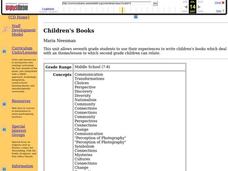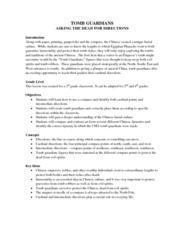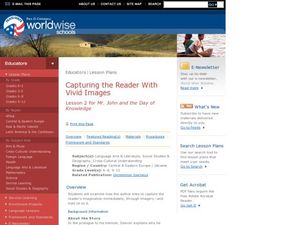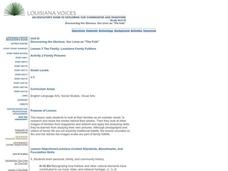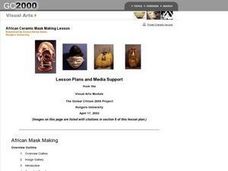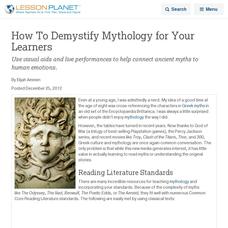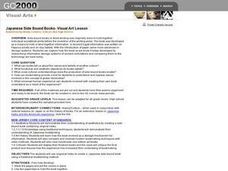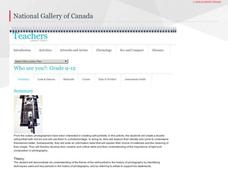Curated OER
Capturing the Reader With Vivid Images
Students examine the use of imagery to hold a reader's attention in an excerpt from John Deever's memoir "Mr. John and the Day of Knowledge". They are introduced to background information about the Ukraine and create original imagery.
Curated OER
Bill O'Rights
Students discuss and identify the first ten amendments to the Constitution and apply their understanding of the material to how they currently affect their lives. They discover the rights and responsibilities of being a citizen, and...
Curated OER
Trade Along the Silk Road
Learners do a jigsaw activity that will enable them to understand the dynamics of the Silk Road trade.
Curated OER
Drosophila Melanogaster
Students cross wild type flies and mutants, both purchased from a biological supply house (Carolina Biological Supply or Wards, for example) in groups from lesson plan one.
Curated OER
Voices From Your Heart
Learners create individual representations of Chinese calligraphy symbols in this cross-curricular lesson plan for the elementary Language Arts or Art classroom. One enrichment activity is included.
Curated OER
Children's Books
Students explore daily dilemmas students face. They write and illustrate a story book dealing with one dilemma. Students write reviews of their books. They read their books to second grade students. Additional cross curriculum activities...
Curated OER
Tomb Guardians
Students practice using compasses to find cardinal directions in this cross-curricular instructional activity about the Chinese art of tomb sculptures. The instructional activity also includes a creative instructional activity extension.
Curated OER
Capturing the Reader with Vivid Images
In this using vivid images worksheet, students identify vivid images and analyze their effectiveness in John Deever's "Mr. John and the Day of Knowledge." Students then write rich images for their classmates to imagine.
Curated OER
When Art Conveys a Political Message
Twelfth graders learn art is an effective way to convey a political message. They learn how political messages are created to convey a message. They analyze a piece of artwork and then write a short paragraph from the point of view of...
Curated OER
The Family: Louisiana Family Folklore
Every family has a different story to share. Your learning community examines the checklist that applies to the lesson, share some of the teacher's family photos, and look for clues in their own family photos in order to complete a...
Curated OER
Review of Adjectives
The easiest way to learn how to use adjectives is through practice, practice, practice! Print out pictures of people and various objects, and have pairs attempt to describe the items together. This plan suggests providing laminated index...
Curated OER
African Ceramic Mask Making
Students investigate a variety of African mask types, design several masks, and create an example of an African ceramic mask in this 5th grade through High School Art lesson. The lesson can take anywhere from 6 lessons to 16 lessons.
Peace Corps
Starting Off the Day (and School Year) in Ukraine
Learners compare the first day of school in Ukraine with the first day of school in the United States, including the challenges students and teachers both face in each country. They respond in class, in their journals, to the following...
Curated OER
Explaining Factors Causing Conflict and Cooperation
Young scholars discuss what causes conflicts amongst groups especially pertaining to Native American tribes. In this conflicts lesson plan, students have discussion questions that they verbally answer and write in a journal.
Film Foundation
Mr. Smith Goes to Washington: What Is a Movie?
Watching is not the same as seeing. Transform viewers from passive watchers to active students of film with this 34-page packet, filled with lessons and activities that use Mr. Smith Goes to Washington to examine the technology, the...
Curated OER
Bog Child
You are destined for an engaged and happy class as they read Siobhan Dowd’s Bog Child because there is nothing missing from this study guide, seriously. This might be the easiest novel to teach because you don’t have to do a thing in...
Curated OER
How To Demystify Mythology for Your Learners
Use visual aids and live performances to help connect ancient myths to human emotions.
Curated OER
Japanese Side Bound Books
Students create Japanese side-bound books using traditional bookbinding methods and original Haikus in this Art lesson for the High School classroom. The lesson can be modified for any grade level and can be accomplished in two class...
Curated OER
Generalizations: How Accurate Are They?
High schoolers recognize and modify generalizations. They challenge generalizations made about people, insist on knowing the evidence that supports these, and be willing to modify their own generalizations when confronted by evidence...
Curated OER
Schools Around the World
Students discover how schools around the world are the same and different. In this international school lesson, students learn about different types of schools from all around the world and the items and activities within these schools....
Curated OER
Seeing Both Sides of an Issue
Young scholars practice the skill of seeing an issue from different points of view.
Curated OER
Using Effective, Amusing Writing As a Model
Learners use the author's writing as a model to achieve vivid description and engaging humor in compositions of their own. They examine the ways a writer can capture and hold a reader's attention and write a short personal narrative...
Curated OER
Who Are You?
Students complete self projects such as a collage, an acrostic poem, a mural, and more, to show their similarities and differences. In this similarities and differences lesson plan, students can do these projects individually or in groups.
Curated OER
Discussion Questions for Amber Bechtel's Essay on AIDS in South Africa
Young scholars read an essay by Amber Bechtel on the situation of AIDS in South Africa. After reading, they participate in a class discussion answering questions posed by their teacher. To end the lesson, they reflect on the situation in...





